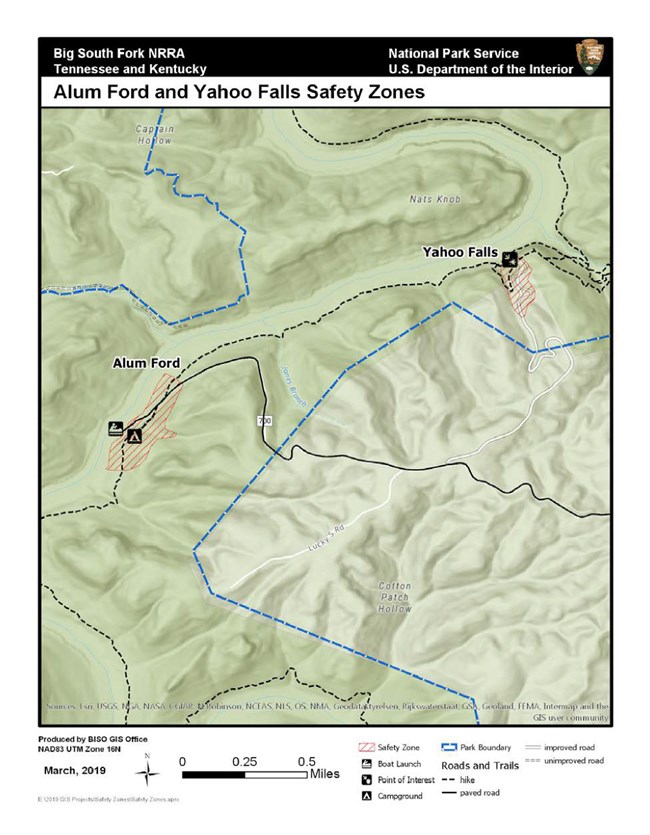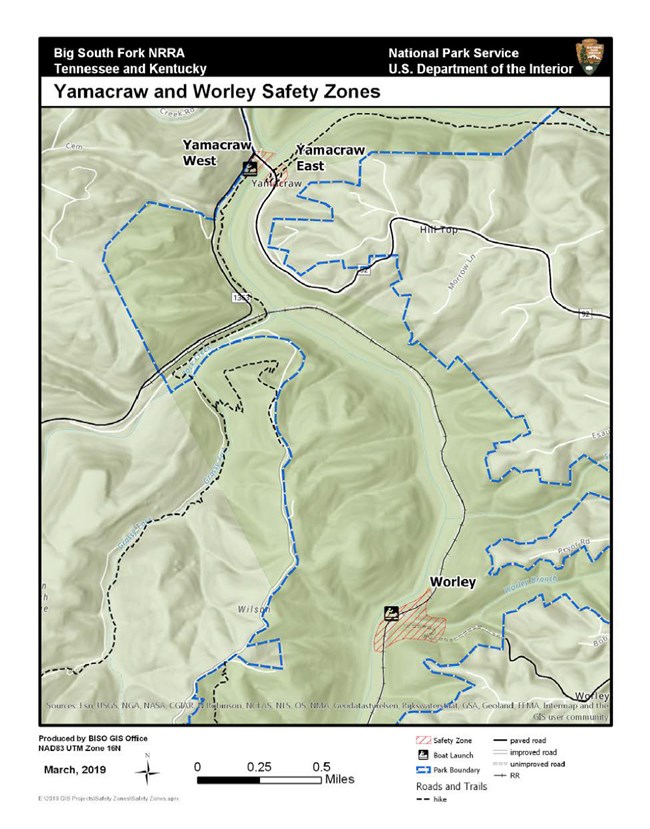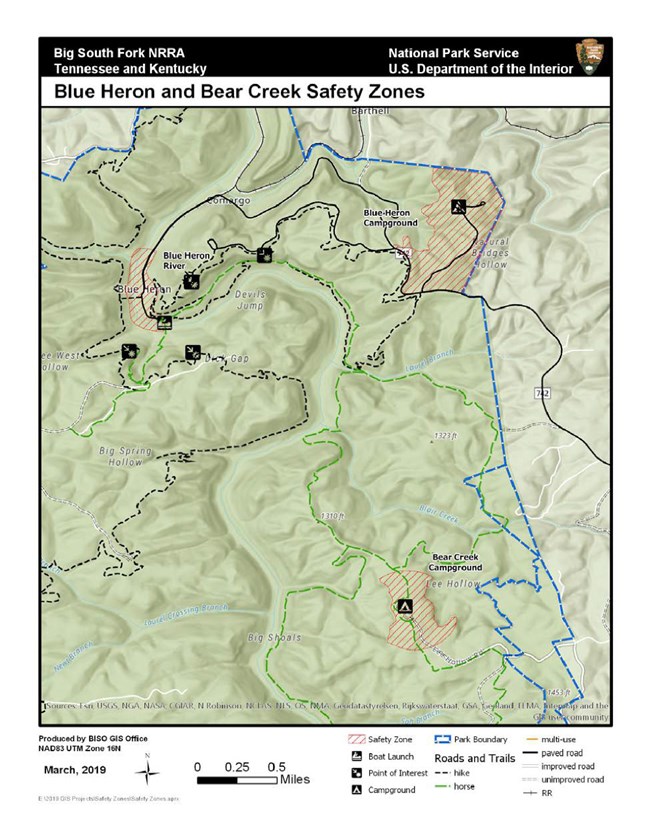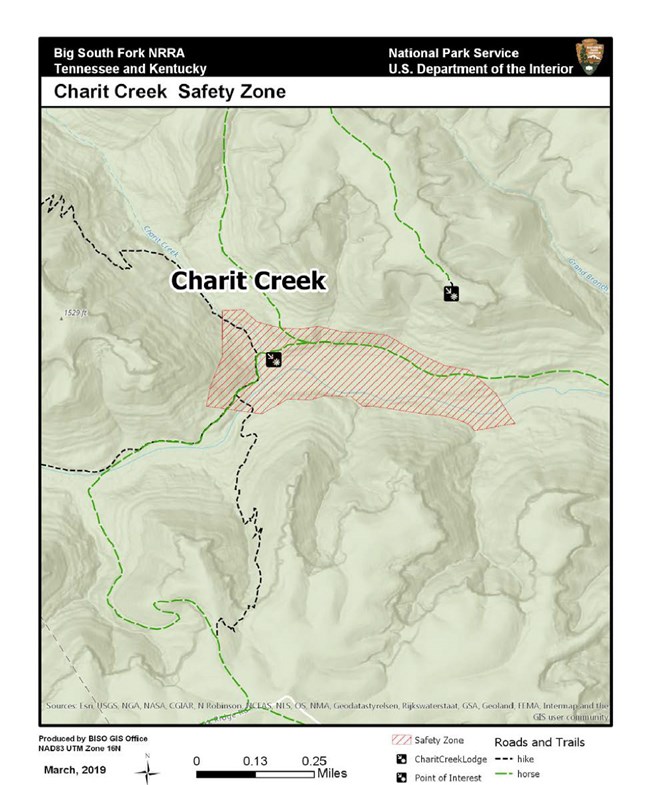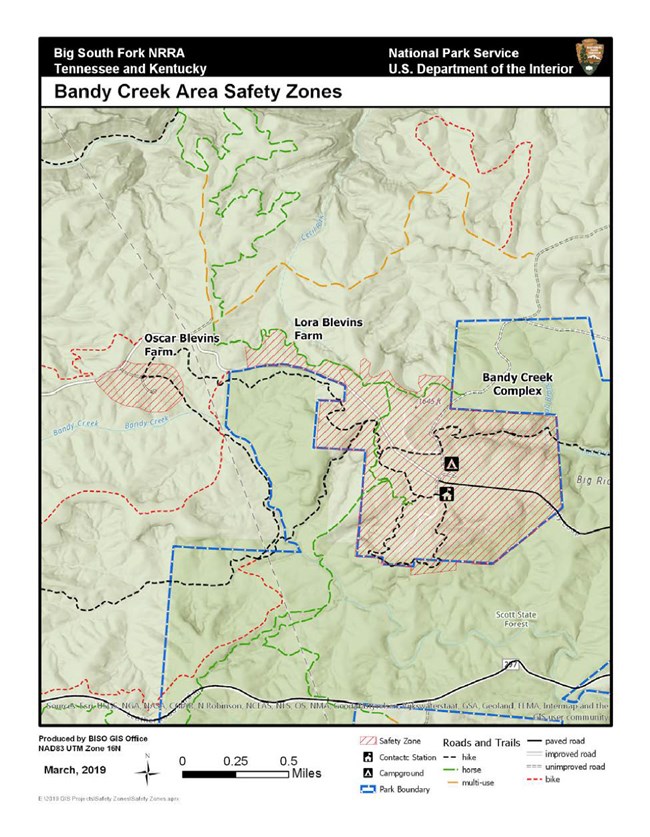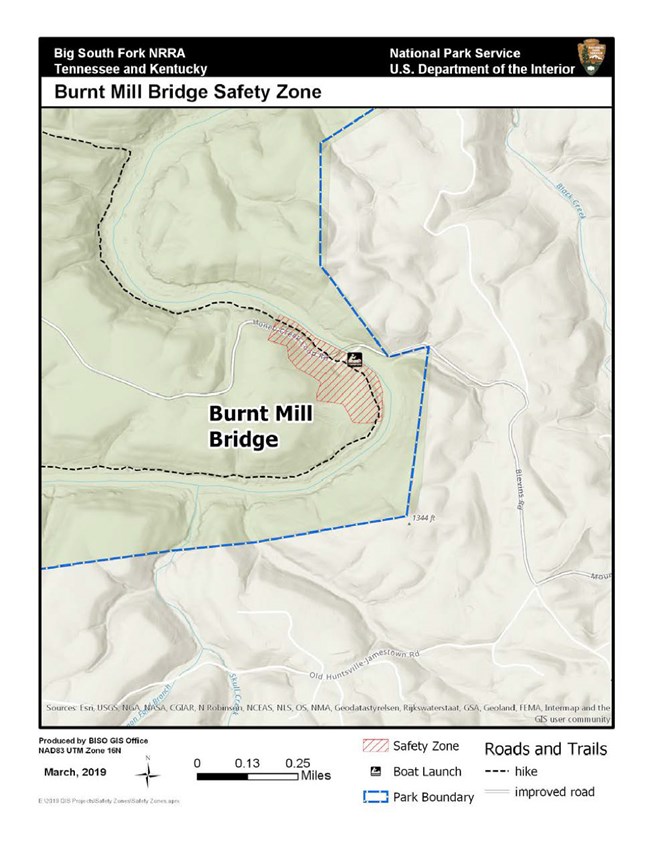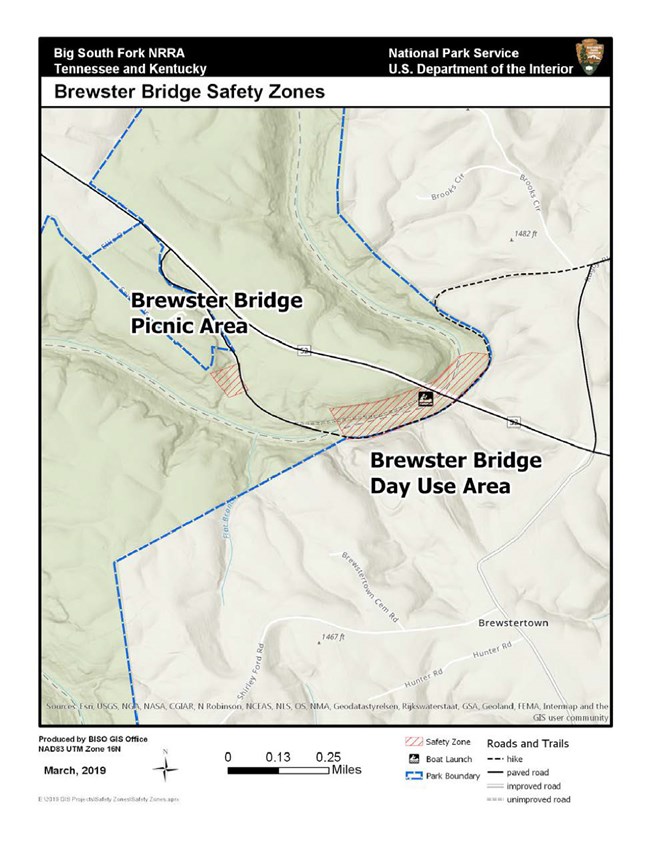|
TOP OF PAGE
—Signed: Niki Nicholas, Superintendent, September 18, 2025. Signature on file.—PART 1—GENERAL PROVISIONS§ 1.5 CLOSURES AND PUBLIC USE PERMITSUSE OF UNMANNED AIRCRAFT(a)(1) Launching, landing, or operating an unmanned aircraft from or on lands and waters administered by the National Park Service within the boundaries of the Big South Fork National River and Recreation Area is prohibited except as approved in writing by the Superintendent. The term “unmanned aircraft” means a device that is used or intended to be used for flight in the air without the possibility of direct human intervention from within or on the device, and the associated operational elements and components that are required for the pilot or system operator in command to operate or control the device (such as cameras, sensors, communication links, etc.). This term includes all types of devices that meet this definition (e.g., model airplanes, quadcopters, drones, etc.) that are used for any purpose, including for recreation or commerce.Justification: The use of unmanned aircraft has the potential to cause unacceptable impacts such as harming visitors, causing excessive noise, impacting viewsheds, and disturbing wildlife. Management Policies 2006 Section 1.5 requires caution when a park is confronted with a new park use such as unmanned aircraft. Less restrictive approaches are deemed to be insufficient, as this closure is a necessary, interim measure which will allow the NPS to consider how to address this new use on a long-term basis. Allowing the use of unmanned aircraft before the park has properly evaluated whether this use is appropriate could result in unacceptable impacts to park resources, park values, and visitor safety. RETURN TO TOP HUNTINGHunting is not allowed on the 21-acre tract of land owned by the National Park Service along Coopertown Road (AKA Highway 297) in Scott County, The area shown on attached map (attached as appendix C).Justification: This area has been designated as a safety zone restricting hunting activities. This narrow tract of land has several nearby residences in every direction with a busy highway along one side. This high concentration of inhabitants and traffic directly conflicts with the ability of hunters to safely shoot or launch a projectile. RETURN TO TOP TEMPORARY CLOSURESEntering any area of the park which has been posted or signed as closed, or which has been designated as closed by the superintendent, is prohibited. Park areas may be closed during emergency situations such as, adverse weather conditions or vehicular accidents and park special eventsJustification: Closures may be necessary for a variety of reasons including site restoration, protection of sensitive or threatened species and protection of human safety. RETURN TO TOP SAFETY ZONES(a)(1) Shooting, trapping and hunting are not allowed within designated safety zones. Safety zones are listed below (attached as appendix D). Kentucky include: Big Creek River Access, Worley River Access, Blue Heron day use area, Blue Heron Campground, Yahoo Falls Picnic Area, Alum Ford River Access and Campground, Yamacraw River Access West, and Bear Creek Horse Camp. Tennessee include: 21 acre tract on Coopertown Road, Station Camp River Access, Station Camp Campground, Charit Creek Lodge Area, Oscar Blevins Farm, Lora Blevins Farm, Bandy Creek Campground Complex, Leatherwood Ford River Access, East Rim Complex, Burnt Mill Bridge River Access, Brewster Bridge (Rugby) River Access and Picnic Area and Peters Ford River Access. You are allowed to walk through the safety zones while hunting as long as your hunting weapon is unloaded, and your dogs are on a leash. Handgun carry permits allow for a handgun to be carried while in the safety zone if not actively hunting with the handgun. Handgun carry must be in compliance with state handgun carry requirements.Justification: Safety zones have been established in order to protect park users and the general public in the listed areas. Safety zones are established around high visitor concentration points, where hunting is incompatible with other visitor uses. RETURN TO TOP MOTORIZED VEHICLES IN THE GORGEThe gorge area, as described in the enabling legislation, is closed to motor vehicle travel on all roads and trails owned by the Government except for those roads specified as access corridors in the enabling legislation, or as determined necessary for administrative/emergency purposes.Justification: The enabling legislation for the Big South Fork National River and Recreation Area, Public Law 93‑251, Section 108, states that no motorized transportation shall be allowed in the gorge area except on designated access routes which are specifically identified in the enabling legislation and amendments. RETURN TO TOP OVERNIGHT PARKING IN FRONT OF BANDY CREEK VISITOR CENTEROvernight parking of all passenger vehicles is prohibited in the small one-way parking lot and the larger parking lot near the amphitheater directly in front of the Bandy Creek Visitor Center.Justification: These parking areas in front of the Bandy Creek Visitor Center are designed for short term daytime parking access to the visitor center and restrooms. If the parking area fills up with longer term parking, then visitor services access could potentially be impacted or prevented for others. Overnight parking is still allowed in the nearby F Loop picnic area parking lot near the transition to the gravel road that leads to the Oscar Blevins Farm as well as the Bandy Creek Pool parking lot. RETURN TO TOP MOTORIZED VEHICLES ON DESIGNATED ROADS AND TRAILSMotor vehicle and e-bike travel are permitted on all designated adjacent area roads and multiuse trails as defined in the 2005 General Management Plan, unless otherwise signed or closed. No live or dead vegetation shall be removed to open roads, trails and multi-use trails that have naturally closed.Justification: The natural closing of roads is one of the most efficient ways to curtail the operation of motor vehicles in unauthorized areas. The reopening of such roads leads to negative impacts on park resources. RETURN TO TOP HARVESTING OF MUSSELSThe entire Big South Fork National River and Recreation Area is closed to harvesting of any species of freshwater mussels.Justification: Many of the Big South Fork NRRA mussels are on either the federal and/or state threatened or endangered species list. In addition, many mussel species are difficult to distinguish from one another. Therefore, to protect the many endangered species, all mussels have been included in this closure. RETURN TO TOP COLLECTION OF BIRDS(a)(1) Collecting or attempting to collect birds, including nesting birds, for any purpose is prohibited.Justification: Although state law allows collection of certain nesting raptors under prescribed circumstances for the purposes of falconry, the collection of such birds is likely to disturb or otherwise damage a wide variety of park resources. RETURN TO TOP MOTORIZED VESSELS ON THE RIVERMotorboats (any vessel equipped with propulsion machinery) are not permitted on the park's river system with the exception of the river section in Kentucky from the northern boundary to a point 1/10 of a mile downstream from Devils Jump. This restriction does not apply to search and rescue vessels or other administrative use.Justification: Motorboats are not allowed on the majority of the park’s streams because of the general prohibition against motorized travel in the gorge area contained in the park’s enabling legislation. That legislation specifically excludes the section of river downstream from Devils Jump. RETURN TO TOP CLIMBING AND RAPPELLING(a)(1) The placement of new fixed climbing anchors is prohibited except as provided below or elsewhere in this Superintendent’s Compendium. An existing fixed anchor may be replaced without a permit provided that the following two conditions are met: (a) the new anchor location must be no more than 24 inches from the location of the previous anchor and (b) the new anchor location must be at least 24 inches from any tree or shrub. The previously existing anchor must be removed when a new anchor is installed to replace it. Persons who will be performing anchor replacement must notify the Big South Fork Chief Ranger of the intended work on the day of and prior to the work being performed. Such work will not be performed as part of a park volunteer event or during any park event in the vicinity of the work location. New fixed climbing anchors may also be installed without a permit in order to establish anchors at the top of a pitch on a traditional route. A “traditional” route is defined as a route that requires climbers to place their own protection as they ascend and on which permanent, fixed anchors are primarily absent. The “top of a pitch” is defined as either the highest point on a given route or, in the case of routes requiring belay points to be established above the ground, the point at which a climber establishes a mid-route belay.Justification: The placement of fixed anchors leads to a high concentration of visitor use in specific areas. However, allowing bolted anchors on traditional routes protects sensitive park resources located along the tops of cliffs. (a)(1) The reinforcement, improvement, creation or alteration of handholds or footholds with glue, epoxy, cement or any other substance is prohibited. The practices of “chipping” and “filing,” and all other practices involving the use of any tools or other implements to reinforce, improve, create or alter any handhold or foothold is prohibited Justification: The altering of the cliff face for the establishment of handholds and footholds has adverse impacts on the scenic and natural quality of the cliff face. (a)(1) Specific climbing routes or climbing areas may be closed to all climbing or rappelling of any sort, upon a finding by the park that sensitive natural or cultural resources are being negatively affected or threatened by such climbing routes or climbing areas. Climbing or rappelling on such closed routes or in such closed areas is prohibited. Justification: It may be necessary to close certain climbing routes or areas upon discovery of sensitive or threatened resources to prevent resource damage. All types of climbing (including sport climbing, traditional climbing, bouldering and scrambling) and all types of rappelling are prohibited in the following locations:
RETURN TO TOP ZIP LINESThe establishment or use of “zip-lines” and rope bridges or similar items is prohibited. “Slack lines” are permitted if they are not left unattended. Trees used as slack line anchors must be padded to minimize damage to the trees.Justification: Zip-lines and similar items create a significant visual impact on the landscape when installed and are difficult to construct without resource damage. Unattended “slack lines” and similar items may tempt other park visitors to use them, leading to the risk of potential injury. RETURN TO TOP GEOCACHES AND SIMILAR ACTIVITIESEstablishment of geocaches is not allowed. No burial of containers, movement of natural items or other manipulation of the natural environment is permitted. The establishment of virtual geocaches is allowed. Virtual geocaching is defined as the activity in which a location is marked or specified by means of Global Positioning System (GPS), map or any means other than a physical marking or object placed at the site of the location, and which is done with the intent that such locations will be searched for or sought out by others.Justification: Physically placing geocaches in the park may lead to the risk that sensitive or threatened resources may be damaged either by the individuals placing the geocache or by individuals seeking the geocache. RETURN TO TOP FIREWOODFirewood, regardless of the species, may only be brought into the park or transported through the park if the tree from which it is derived originally stood in Scott County, Fentress County, Pickett County or Morgan County, Tennessee or in McCreary County, Kentucky. Possession of kiln dried store-bought firewood will also be allowed as long the possessor can provide proof that the wood has been treated and does not contain invasive pests. Possession of all other firewood that originated outside the local area is prohibited.Justification: Bringing in firewood from outside of the immediate local area poses the risk of introducing forest pests such as the Emerald Ash Borer. RETURN TO TOP PERMITSAny group larger than 25 persons wishing to participate in any activity in the park in which members of the group will depart from an established road, trail or parking area must first obtain a permit for such activity. (Boating activities are not covered by this provision.) Participating in such an activity without a permit is prohibited.Justification: The use of the backcountry areas by large, organized groups results in significant impact to park resources and often interferes with the use and enjoyment of other visitors. The requirement of a permit allows park staff to inform group leaders about park rules and regulations and about ways to mitigate impacts to park resources and visitors. RETURN TO TOP SEARCHING REFUSE CONTAINERSThe searching of government owned refuse containers and the removal of recyclable materials from these containers by persons other than an official collection contractor or authorized NPS staff member is prohibited.Justification: The searching of trash receptacles presents a health hazard and leads to littering and interferes with the enjoyment of other park visitors. RETURN TO TOP IDLING OF ENGINESDrivers are prohibited from idling engines of commercial passenger-carrying motor vehicles in parking lots.Justification: The noise and fumes caused by these engines disturbs other park visitors and wildlife. RETURN TO TOP MOTORIZED VEHICLES NOT DESIGNATED FOR HIGHWAY USEMotorized vehicles, such as ATV’s and golf carts, not designed, intended or licensed for on highway use as dictated by state law are prohibited on public roads including campground roads, parking lots, day use areas and trails within the Big South Fork NRRA. This restriction does not apply to motorized wheelchairs used by persons with a disability or vehicles used for administrative purposes. The use of a Segway by persons with disabilities will be accommodated within the campgrounds from the accessible campsites and bathroom facilities. Other than the previously listed areas, Segway use is limited to Leatherwood Ford and Burnt Mill parking and picnic areas. Unregistered off-road vehicles such as ATV’s and UTV’s are allowed on multi-use trails during big game hunting season when the operator is actively hunting and has a valid license to hunt. The use of these vehicles is only permitted on the immediate surface of the maintained road or multi-use trail. Tennessee State Law states that ATV and UTV use is allowed on the O&W Road section from Verdun Road to North White Oak Creek and therefore not governed by this regulation.Justification: Golf carts, ATVs, and similar motor powered pieces of equipment, as defined by state law, which are not designed or licensed for use on public roads present a safety hazard for the machine operator as well as other park visitors and can cause accelerated resource damage and user conflicts if used in undesignated areas. RETURN TO TOP GLASS CONTAINERS(f) Glass containers are prohibited on the Big South Fork River and major tributaries or within 50 feet of the river or any creek. Glass containers are prohibited within the fenced area at the Bandy Creek Pool.Justification: Broken glass presents a serious safety risk. RETURN TO TOP SWIMMING(f) Swimming is prohibited within 200 feet of the Alum Ford, Blue Heron, Big Creek or Yamacraw boat ramps.Justification: Motorboat traffic is often heavy in these areas, presenting a serious safety risk to swimmers. RETURN TO TOP WAGONS(2) Wagons are allowed on all roads or multi-use trails as long as they are properly marked per state law. Wagon use on campground roads is prohibited. Travel from East Bandy Road to Duncan Hollow road via the campground road past the pool is permitted.Justification: Wagon use poses a risk to other visitors in park campgrounds. For the O&W Wagon Use Pilot Project, Wagons are allowed on the O&W and Tar Kiln trail. Access points are at the Mill Creek, Zenith and Tar Kiln gates. Keys for access to these trails must be checked out at Park Headquarters Monday through Friday between the hours of 9 a.m. and 4 p.m. Eastern Standard Time. Justification: To determine if use is needed and compatible with current use. RETURN TO TOP ENTERING CAVES AND MINE SHAFTS(a)(1) Entering any cave or mine shaft within the park is prohibited except where a permit has been issued. A cave is defined as any naturally occurring void, cavity, recess, or system of interconnected passages which occurs beneath the surface of the earth or within a cliff or ledge and which is large enough to permit an individual to enter, whether or not the entrance is naturally formed or manmade. Such term shall include any natural pit, sinkhole, or other feature is an extension of the entrance.Justification: Entering caves and abandoned mines is prohibited due to the unsafe conditions that may exist within those areas. This closure is also meant to protect fragile natural resources, including threatened or endangered species, from exposure to White-Nose Syndrome (WNS). RETURN TO TOP JUMPING FROM BRIDGES(a)(1) Jumping or diving from any bridge within the park is prohibited.Justification: Hazards (such as deceptively shallow water, submerged objects and roadway traffic) make jumping or diving from bridges an unsafe activity. Additionally, such activities pose danger to individuals who may be in the water below the bridge or travelling on the roadway. RETURN TO TOP ROPE SWINGS, DIVING BOARDS, LADDERS AND SIMILAR ITEMS(a)(1) Attaching or otherwise affixing a rope swing, diving board, ladder, slide or other such item to the shore of any stream within the park, to an object or to vegetation alongside such stream, or to an object or vegetation within the stream itself, is prohibited.Justification: Rope swings and other similar items pose significant hazards to those that use them and result in resource damage. RETURN TO TOP STACKING ROCKS OR SIMILAR ACTIVITIES(a)(1) Stacking rocks for any purpose or using rocks to create any sort of rock structure is prohibited. This provision does not apply to the use of rocks to create temporary fire rings as further described in Section 2.13 of this superintendent’s compendium. Such temporary fire rings must be less than 6 feet in diameter along their outer edge and less than 12 inches in height. Rocks used for the construction of such fire rings must be collected from the surface of the ground only. Rocks which are partially or fully buried may not be disturbed.Justification: The use of rocks to construct cairns, chairs, benches and other rock structures alters the landscape from its natural condition and in many cases detracts from the scenic beauty of the park. Disturbing rocks from their natural state can also alter or destroy habitat for a wide range of plant and animal species. RETURN TO TOP HUNTING DOG TRAINING(a)(1) The training of hunting dogs to chase, tree, trail, or find wildlife, outside of defined hunting seasons is prohibited.Justification: The training of hunting dogs on live animals within the park but outside the defined hunting seasons directly conflicts with existing state and federal laws that prohibit the harassment of wildlife. RETURN TO TOP ADVENTURE RACES AND SIMILAR ACTIVITIES(a)(2) Any activity in which persons compete with one another by traveling along a course within the park, including, but not limited to, triathlons, adventure races, eco-challenges, iron man competitions, hash house harrier games (also known as “hashing”), and other races or competitions of any sort, must be conducted pursuant to a permit issued by the Superintendent.Justification: Activities such as adventure races can significantly interfere with the use and enjoyment of other park visitors and may impact sensitive resources. The requirement of a permit allows park staff to mitigate the impact of such activities on other visitors and determine if resources will be impacted. The requirement also allows park staff to limit off-trail portions of such activities to areas where sensitive resources will not be negatively affected. RETURN TO TOP DRAFTING LARGE AMOUNTS OF WATER FROM RIVERS, STREAMS, AND PONDS(d) The drafting of large amounts of water from any river, stream, pond or other water source within the park must be conducted pursuant to a permit issued by the Superintendent.Justification: Drafting of large amounts of water, which typically involved motorized mechanical pumps and the diversion of water, may impact sensitive resources and can significantly interfere with the use and enjoyment of other park visitors. The requirement of a permit allows park staff to mitigate the impact of such activities on other visitors and determine if resources will be impacted. This rule does not apply to the use of personal water purification pumps that are commonly used in backpacking for personal water consumption. RETURN TO TOP FILMING, PHOTOGRAPHY, AND AUDIO RECORDING(a)(2) Filming, still photography, and audio recording activity may require a permit, consistent with 54 U.S.C 100905. § 1.6 PERMITSPursuant to the provisions of 36 CFR 1.6(f), the following is a compilation of the activities for which a permit is required. Not all the activities/permits listed below are relevant to the Big South Fork National River and Recreation Area.
Permits will be specific in nature to the activity being permitted. In those cases where permit use is frequent, a specific permit form has been designed (e.g., the Alum Ford Campground self-registration form). In most other cases, a special use permit or letter of authorization will be prepared describing the specific conditions under which the permitted activity is authorized. In all cases, a permit or letter of authorization must always be in the permittee’s possession and must be shown to any authorized person upon request. For the purposes of self-registration at Alum Ford Campground, the application requirement is met by completing the fee collection envelop fully and accurately, inserting the required payment into the envelope, depositing the envelope in the security container of the self-registration station, and by affixing the appropriate, completed portion of the envelope to the clip on the site marker provided for that purpose. RETURN TO TOP PART 2—RESOURCE PROTECTION, PUBLIC USE AND RECREATION§ 2.1 PRESERVATION OF NATURAL, CULTURAL AND ARCHEOLOGICAL RESOURCESWOOD(a)(4) Dead wood on the ground may be collected anywhere in the park for use as fuel for campfires within the park.Justification: Downed, dead wood is generally plentiful within the park. RETURN TO TOP FOOD HARVESTING(c)(1) Reasonable quantities (one bushel/day/family for apples, pears, plums and peaches, and two gallons/day/family of all other species listed below) may be gathered for personal use or consumption:
RETURN TO TOP § 2.2 WILDLIFE PROTECTIONBEAR HUNTING(b)(2) Bear hunting is not allowed inside the park.Justification: Traditional bear hunting methods conflict with the park's increasing visitation and other recreationtional activities. The Park is waiting for the states to develop consistent long term bear management strategies. RETURN TO TOP HOG HUNTING(b)(2) Hog hunting is permitted during the regularly established deer season for the relevant state. Additionally, within the Tennessee portion of the Big South Fork only, there will be a special park hog hunting season beginning on the day following the conclusion of the last deer hunt in January and continuing through the last day of February. Hog hunting within the Kentucky portion of the Big South Fork is not permitted beyond the state established deer season. In addition to the appropriate state license, a Big South Fork hog hunting permit is required. Hogs may only be taken with weapons approved for use in the taking of deer during daylight hours. Hog hunting with dogs is prohibited within the park.Justification: Allowing hunting of this non-native species will help control hog populations and will also aid adjacent landowners whose crops are being impacted by feral hogs. RETURN TO TOP BAITING WILDLIFE(b)(2) The placement of salt licks, mineral blocks, food items or "baiting" to attract wildlife to a specific area is prohibited. Hunting over an area that has been baited is prohibited. Trapping is allowed using the legal methods according to the state regulations.Justification: The use of these items has the potential to introduce non-native species and other materials that may be harmful to park resources or that are not a natural part of the diet of the park’s animals. 36 CFR 2.2 (a)(2) prohibits the feeding of wildlife. RETURN TO TOP TRAMMING HUNTING DOGS(b)(4) The practices known as trolling and tramming, which is defined as allowing dogs to run along beside or ride on the exterior of a vehicle or horse in order to strike scent of wildlife, and any related activities are prohibited.Justification: This practice is in conflict with state law which prohibits a person from hunting, shooting at, chasing, catching or killing, with or without dogs, any wild animal from a public road or right of way. Hunting dogs must be restrained on a leash not to exceed 6 feet, crated or caged within all designated safety zones. Justification: Restraining hunting dogs in areas where hunting is prohibited prevents the disturbance of wildlife and endangerment of persons. RETURN TO TOP HUNTING FROM A HORSE OR OTHER ANIMAL(b)(2) Hunting from a horse or other animal is prohibited within the park.Justification: Hunting from horseback conflicts with the park's increasing visitation and other recreational activities. It poses an unnecessary safety concern to the rider and other visitors. RETURN TO TOP RETRIEVING LAWFULLY TAKEN GAME(d) In the backcountry, lawfully taken big game animals may be quartered for ease of transportation so long as species and sex can be determined. A pack animal may also be used to remove lawfully taken big game. Hunters are required to retrieve all crippled or dead game if possible and are prohibited from disposing of dead wildlife in the park.Justification: Hunters are required to retrieve game when feasible to discourage waste. RETURN TO TOP DISPOSING OF DEAD ANIMALS(a)(1) Disposing of dead animals, including lawfully taken game is prohibited.Justification: The disposal of dead animals within the park detracts from the experience of other visitors and can cause public health issues. RETURN TO TOP VIEWING WILDIFE WITH ARTIFICIAL LIGHT(e) The entire park is closed to viewing of wildlife with an artificial light (including headlights), except when in accordance with state laws which permit such use for specific species. Spotlighting coyotes is not allowed.Justification: The prohibition of viewing wildlife with an artificial light is necessary to protect wildlife against nighttime poaching and is consistent with applicable state hunting regulations. RETURN TO TOP § 2.3 FISHING(a) Tennessee and Kentucky State Fishing Regulations are adopted for management of fisheries within the Big South Fork National River and Recreation Area.RETURN TO TOP POSSESSION AND USE OF BAIT(d)(2) Regulations regarding fishing bait are state specific and found in the state fishing regulations. All sections of park streams are open for the possession and use of live or dead native bait fish or fish eggs. Non-native fish species or the eggs of non-native fish species may not be used within the Big South Fork. Endangered or protected native species are already regulated by law and may not be used as bait.Justification: The use of native minnows and other bait species does not pose a risk to park resources. However, the use of non-native species as bait risks the introduction of invasive species to park waters. RETURN TO TOP § 2.4 WEAPONS, TRAPS, NETSFIREARMS REGULATIONSAs of February 22, 2010, a federal law allows people who can legally possess firearms under applicable federal, state, and local laws, to legally possess firearms in this park. It is the responsibility of visitors to understand and comply with all applicable state, local, and federal firearms laws before entering this park.Federal law also prohibits firearms in certain facilities in the park; those places are marked with signs at all public entrances. RETURN TO TOP § 2.10 CAMPING AND FOOD STORAGECAMPINGCamping limitations are as follows:(b)(3) Traditional camping along the river flood plain is permitted, regardless of whether the campsite is more or less than 100 feet from the river. All other camping regulations are in effect. Justification: The areas along the park’s streams are regularly scoured by floodwaters and are not necessarily more subject to resource damage than any other area of the park. (b)(9) Camping is limited to 14 consecutive days in a single site and a total of 30 cumulative days in a calendar year. Justification: These stay limits are in effect to allow fair and reasonable access to all campers and minimize resource impacts. RETURN TO TOP WILDLIFE CARCASSES(b)(6) Displaying wildlife carcasses or other remains or parts thereof, is prohibited in designated campgrounds.Justification: Displaying wildlife carcasses or other remains or parts is potentially unsettling to other campers as well as creating unsanitary conditions that may affect other campers. RETURN TO TOP CAMPGROUNDSUnless otherwise designated, horses and livestock are not permitted (trailered or untrailered) in developed areas and campgrounds. Administrative use is excepted.Justification: Possession of horses and livestock in campgrounds not designated for such use raises issues relating to public health and the desired visitor experience. The construction of temporary fixtures or structures to house or contain animals, such as corrals, fences, hot wires, barricades, paneling, etc. is prohibited in developed campgrounds. Livestock shall only be housed in park provided stalls, visitors trailers, or other areas designated specifically for that intended use. Justification: The construction of these types of fixtures brings with it a risk of damage to park resources, may pose a risk to public safety and they typically occupy space outside the designated camp site that the visitor is renting which could also affect the overall experience for other area visitors. Camping fees, where applicable, are due upon occupying a campsite. Sites for which required fees are not paid will be considered unoccupied and available for use. Justification: Clearly specified procedures concerning campsite registration are required to help eliminate disputes over specific sites and to ensure compliance with registration requirements. Sites may not be left unattended for more than 24 hours. Justification: Campsites left unattended for more than 24 hours are sources of potential problems with wildlife and may encourage criminal activity such as theft. Entry and occupancy of developed campgrounds is limited to registered vehicles and campers only between 10 p.m. and 6 a.m. ET. Justification: Entering the campground by motor vehicle between 10 p.m. and 6 a.m. EST is a source of disruption to other campers. Occupancy of developed campgrounds is limited to one (1) immediate family or six (6) persons per campsite, except group sites where the limit is based on established fees. Justification: Limitations at individual campsites help limit resource impacts and preserve a better experience for other campers. Campground check out time is 10:00 am ET for group campsites and 12:00 pm ET for individual campsites. Justification: A designated check out time for outgoing occupants is required so incoming occupants are able to check in to a site at a reasonable time. Blue Heron Campground, Bear Creek Campground, and Bandy Creek Campground Loops A, B, and C are closed from December 1 through March 31 each year. The Bandy Creek Group Campground loops E1 and E3 are closed on the first Monday after Thanksgiving through March 31 each year. Justification: The campgrounds have utilities that require winterization to prevent damage during cold weather seasons. Use of the shared horse corrals located in Bear Creek Campground and Station Camp Campground are limited to one (1) hour per user during daylight hours only. Justification: These corrals are provided for horses to "cool off" after a trail ride or as an area to prepare a horse for riding. The number of visitors requesting use of the corrals exceeds the number of corrals available so timed use must be regulated to provide an opportunity for more than one visitor. RETURN TO TOP POWER AND WATER AT CAMPSITE(b)(7) Only one camping unit is permitted to be connected to the power and water supplies at each campsite.Justification: If more than one camping unit connects to the water or electric supply the potential for damage to the campground utilities is much higher. (b)(9) No person, party, or organization shall be permitted to camp in Big South Fork National River and Recreation Area for more than a total of 30 days in a calendar year. Backcountry permits are required and are valid for a single camping trip not to exceed 14 days at one site. Equipment must be moved after 14 days. Justification: Limitations relating to length of stay help ensure camper turnover and allow campsite vegetation a better opportunity to recover. Camping is prohibited in areas being restored or re-vegetated and in areas that are highly impacted and are closed for rehabilitation. Justification: Impacted areas may need to be protected from excessive human intrusion until rehabilitation can be completed. (b)(9) Generator use and the idling of engines in park campgrounds is prohibited between the hours of 10:00 p.m. and 6:00 a.m. Justification: Noise and noxious fumes produced by generators and other internal combustion engines is counter to the atmosphere sought by many campers, especially at certain times of the day or when present for extended periods of time. These restrictions are intended to accommodate various user groups while providing a peaceful sleeping environment for all. Camping is prohibited within 100 feet of a cultural landscape, cave, rock shelter, arch, or trail and within 100 feet of a grave site or historic structure. Camping is also prohibited in all historic cabins or other historic structures or sites. Established and obvious campsites that currently exist outside the above areas will be allowed if not in conflict with other provisions. Tent camping only at the Station Camp river access area. Justification: Camping is prohibited in certain areas to help prevent a visual intrusion on the experience of other park visitors and to protect park resources. No camping is permitted at a location within 100 feet of the centerline of or visible from any paved road. Justification: Camping is prohibited in certain areas to help prevent a visual intrusion on the experience of other park visitors and to protect park resources. Camping is not permitted within any designated parking area. Camping is not allowed within 300 feet of the Leatherwood Ford day use area north of the Leatherwood Ford parking area. In addition all areas immediately adjacent to the East Bandy Creek Road, from State Hwy 297 west to Scott State Forest and West Bandy Creek Road to Scott State Forest, are closed to camping. (This area is otherwise known as the Bandy Creek Fee Area.) Justification: Camping is prohibited in certain areas to help prevent a visual intrusion on the experience of other park visitors and to protect park resources. All areas within Bandy Creek, Blue Heron, Station Camp Campground, and Bear Creek Horse Camp fee areas are closed to backcountry camping. Justification: Camping is prohibited in certain areas to help prevent a visual intrusion on the experience of other park visitors and to protect park resources. Parking more than two vehicles, trailers inclusive, at a developed campsite is prohibited. Justification: The limited availability of parking and narrowness of the campground roads requires that parking be done in a controlled manner. Parking vehicles off established surfaces in developed areas and campgrounds is prohibited unless administratively approved. Justification: Parking off paved parking surfaces can cause damage to vegetation and create a potential safety problem. The immediate four (4) feet from the pavement onto the gravel pad is considered part of the designated camping area. No motorized vehicles are permitted on this section. Trailers may, however, be parked on this gravel pad. Justification: Parking motor vehicles off of paved areas of campsites poses a threat to park resources. RETURN TO TOP FOOD STORAGE(b)(9) All unattended wildlife attractants must be properly stored in the same manner as unattended food within the park. Wildlife attractants are defined as any item that gives off an odor that would attract an animal. Some example of wildlife attractants include, but are not limited to, animal feed (excluding baled hay) and personal hygiene products such as soaps, cosmetics, deodorant, perfume, and toothpaste.Justification: Food storage requirements will help eliminate conflict between visitors and wildlife and will help prevent park wildlife from coming to view humans as a source of food. RETURN TO TOP § 2.11 PICNICKINGPicnicking is allowed within the park. Provided, however, that picnicking in developed campground is permitted only to registered campers that have completed the required self-registration process for their campsite and to the invited guests of such campers. Additionally, all refuse, trash and other such items must be maintained in an appropriate refuse container at all times; failure to place such items immediately into an appropriate refuse container is prohibited. Picnicking is prohibited within 100 feet of an area of cultural or archeological significance or a research site or plot.Justification: Not placing items of refuse immediately into an appropriate receptacle creates greater potential for problems with scavenging wildlife and littering. Picnicking at or near cultural areas poses the risk of damage to such areas. RETURN TO TOP § 2.13 FIRES(a)(1) Ground fires, which includes the burning of wood, charcoal and use of biomass stoves, are allowed within the boundary of Big South Fork NRRA at backcountry campsites for campers in possession of a backcountry camping permit. Fires are allowed in the front country within designated fire rings and cooking structures. The use of petroleum stoves is also permitted throughout the park. Fires and use of stoves are prohibited in parking areas, on park roads, on park trails, on cliff ledges and within 100 feet of historic structures, cabins, cemeteries, arches and rock shelters.Justification: Fire can pose a serious threat to visitor safety, park facilities, natural resources, and cultural resources if not managed appropriately. (a)(1) A fire may be ignited and maintained only by using fuel sources designed and commonly used for warmth or the preparation of food, such as charcoal briquettes or natural firewood. Lighting or maintaining a fire with other materials including, but not limited to, flammable liquids, garbage, fireworks, plastics, aerosol canisters, batteries, or other manufactured or synthetic materials, is prohibited. Justification: This action is necessary for the maintenance of public health and safety, protection of environmental or scenic values, protection of natural or cultural resources, and the implementation of management responsibilities. Materials other than approved combustibles – especially fire accelerants and substances prone to wind transport or explosion – creates serious risks when used to light or maintain fires. These combustibles can ignite or spread wildfires that directly threaten people and valuable resources and assets. The burning of manufactured or synthetic materials can contribute to air pollution, contaminate soil and water, and be toxic to humans and the environment. Less restrictive measures, such as an education campaign informing visitors of the risks of using certain materials to light or maintain a fire, would not be commensurate with the substantial risks associated with those activities and could lead to adverse outcomes that might be prevented by establishing an enforceable condition. RETURN TO TOP § 2.14 SANITATION AND REFUSEDISPOSAL OF HUMAN BODY WASTE(b) Within a distance of one-quarter of a mile from a restroom or pit toilet facility, human body waste must be appropriately disposed of in such facilities. Beyond a distance of one-quarter of a mile from such facilities, human body waste must be containerized and carried out or it must be buried at a depth of 4 to 6 inches in organic soil and at a location not frequented by the public. Human waste may not be buried within 100 feet or in sight of any trail, road, parking lot, developed area, campsite, cliff or rock formation, climbing route or climbing area, water source or the high-water mark of any stream, whether intermittent or not.Justification: Improper disposal of human waste is a potential health hazard. RETURN TO TOP § 2.15 PETS(a)(3) Leaving a pet unattended or tied to an object is prohibited.Justification: This provision helps provide for the humane treatment of animals and helps to limit the noise nuisance of unattended, barking dogs. (a)(5) In developed areas, pet excrement must be immediately collected by the pet handler or owner and disposed of in the nearest trash receptacle. Justification: Improper disposal of pet waste is a potential health hazard. RETURN TO TOP § 2.16 HORSES AND PACK ANIMALS(a) Designated pack animals are donkeys, horses, mules, llamas and goats.(b) Horseback riding is only permitted on designated horse trails and multi-use trails and on the following:
Justification: Horseback riding in areas other than those listed above would create a safety hazard to pedestrians and vehicles, a sanitation problem, and could negatively impact a resource not designed for horse use. RETURN TO TOP MANURE REMOVALAt trailheads, parking facilities and campsites near developed areas or roads, manure must be removed from the site and taken from the area. In overnight campsites located in the backcountry, manure deposited must be scattered in the edge of the woods at least 100 feet from any existing water source.Justification: Manure left at park areas detracts from the enjoyment of park resources. RETURN TO TOP TYING OF HORSES AND OTHER ANIMALSHorses and pack animals are prohibited from being tied to trees, shrubs or other vegetation in such a manner as to allow damage to the vegetation. Tying to historic structures is prohibited. Horses are not permitted within cemeteries.Justification: Tying horses and other animals to structures and vegetation damages park resources. Horse camps and areas where horses are tied temporarily must be located at least 100 feet from a water source. Justification: This provision is necessary for public health and sanitation. RETURN TO TOP COGGINS TESTING AND HEALTH CERTIFICATEHorses or other members of the Equidae family being transported into, through or ridden on trails within the park shall be accompanied by evidence that it has tested negative on an official test for Equine Infectious Anemia (EIA) (Coggins Test) conducted not more than twelve (12) months prior to entering the state.Horses, mules or other Equidae transported into, through, or ridden on trails within the park from out of state shall be accompanied by an official certificate of veterinary inspection (CVI), health certificate, or Equine Interstate Event Permit also known as an equine passport. The above pertains to both the Tennessee and Kentucky areas of the park and all proof of negative testing and inspection must be in possession of the horse handler at all times. Justification: Coggins test paperwork and proof of veterinary inspection helps to ensure that all livestock utilized at the park are compliant with state law and helps to ensure the safety and well-being of all livestock at the park. RETURN TO TOP § 2.20 SKATESSKATINGSkating, skateboards, rollerblades, etc., are permitted only at the Bandy Creek trailhead area and bathroom parking lot.Justification: Other areas of the park are considered unsafe for the use of skates and similar items. It is not to be implied, however, that skates and similar items may be used in the areas listed above without the risk of injury. RETURN TO TOP § 2.21 SMOKING(a) Smoking in government buildings is prohibited.Justification: Second-hand smoke has negative health consequences for other visitors and park staff. RETURN TO TOP § 2.22 PROPERTYVEHICLES(a)(2) Visitors involved in extended hikes and river trips may leave their vehicles unattended for longer than 24 hours if they have a valid backcountry permit.Justification: Motor vehicles may be left unattended to permit participation in backcountry activities. (b)(2) In the event of a natural disaster or emergency incident, such as major flooding, wildland fire or a rescue operation, park management reserves the right to tow unattended vehicles parked in a threatened area or parked in a manner or place which would impede an emergency operation. Vehicles will be towed to an established more suitable location at the owner’s expense. Every effort to notify the vehicle owner of the changed vehicle location will be made but due to all the variables of the vehicle owners’ activity this may not be feasible. The sheriff’s office dispatch for the county in which the vehicle is parked will be notified of the change in location to help disseminate the information. Justification: Occasionally unattended vehicles need to be moved from their current location to protect the private property from damage, protect park resources from damage or to further facilitate an emergency response. RETURN TO TOP TREE STANDS(b)(2) The use and/or construction of permanently affixed tree stands and access steps to tree stands are prohibited. Portable or temporary tree stands that do not damage trees may be used. Typically leaving any personal property unattended for more than 24 hours is prohibited, however, Big South Fork has elected to allow properly labeled tree stands to remain in the field for 48 hours. Tree stands must be marked with the hunter’s last name and date it was placed. Stands must be removed within a week of the final date of big game hunting season. Trimming or cutting trees to accommodate tree stands is prohibited. No vegetation can be cut or trimmed to provide “shooting lanes” around the tree stand.Justification: Permanent and temporary hunting stands have the potential to damage trees and other vegetation. RETURN TO TOP § 2.31 TRESPASSING, TAMPERING AND VANDALISMRAILROAD TRACK TRESPASS(a)(1) Entering, traveling on, or remaining on any active railroad track or rail line within the park is prohibited without the express invitation or consent from the organization who has lawful control of the property.Justification: Pedestrian presence on active railroad lines creates hazardous condition for both railway operators and park visitors. § 2.35 ALCOHOLIC BEVERAGES AND CONTROLLED SUBSTANCESALCOHOL CONSUMPTION(a)(3)(i)(A) The consumption of an alcoholic beverage and/or the possession of a bottle, can or other receptacle containing an alcoholic beverage that is open or that has been opened, or whose seal is broken or the contents of which has been partially removed is prohibited:
Consumption of alcohol is allowed by registered campers in their assigned campsite and backcountry campers with a valid backcountry camping permit within their established backcountry campsite, i.e. readily apparent that the intent is to legitimately backcountry camp in the site. Justification: In the locations listed above, the consumption of alcoholic beverages and the possession of open containers of alcoholic beverages are inappropriate considering the other uses of those locations and the purposes for which they were established and are maintained. (a)(3)(i)(A) The consumption of an alcoholic beverage and/or the possession of a bottle, can or other receptacle containing an alcoholic beverage that is open or that has been opened, or whose seal is broken or the contents of which has been partially removed is prohibited while riding a bicycle, e-bikes, riding on a horse or other livestock, operating or riding in a vehicle drawn by a horse or other livestock or while operating or riding on or in an ATV or UTV. Justification: The consumption of alcoholic beverages and the possession of open containers of alcoholic beverages by individuals riding bicycles, e-bikes, horses or other animals create a safety risk for park visitors. RETURN TO TOP § 2.51 DEMONSTRATIONS(e) See Appendices A & B for maps of locations where demonstrations, as defined in 36 CFR 2.51 and subject to the requirements contained therein, are allowed.RETURN TO TOP § 2.52 SALE OR DISTRIBUTION OF PRINTED MATTER(e) See Appendices A & B for maps of locations where the sale and distribution of printed material, as defined in 36 CFR 2.52 and subject to the requirements contained therein, are allowed.RETURN TO TOP PART 4 - VEHICLES AND TRAFFIC SAFETY§ 4.10 TRAVEL ON PARK ROADS AND DESIGNATED ROUTESOFF ROAD VEHICLES(b) Rail buggies and other off-road vehicles must be equipped with a U.S. Forest Service approved spark arrester and functioning muffler. Straight pipes are prohibited.Justification: Requiring spark arresters and mufflers on rail buggies and other off-road vehicles lessens noise pollution and the possibility of wildfires. (c)(1) Tracked vehicles are prohibited within the park except for administrative use. Justification: Tracked vehicles can produce significant damage to park roads and trails, which are not designed for such use. RETURN TO TOP § 4.21 SPEED LIMITS(b) The maximum speed limits on all paved, public roads in the park are as posted. The maximum speed limit on secondary roads and multiuse trails are 25 miles per hour unless otherwise posted. Conditions will necessitate lower limits on certain roads. Driver discretion is required. Secondary roads include all gravel and logging roads within the park boundaries.Justification: Road conditions on secondary roads such as narrow width, rough surface, steep grades and limited visibility dictate that a maximum 25 miles per hour speed limit be set for safety purposes. RETURN TO TOP § 4.30 BICYCLES(d) Bicycles are permitted on multi-use trails, bicycle trails and some horse trails as designated by the 2005 GMP. Electric bikes are only permitted on multi-use trails, public roads, and parking lots.Justification: The use of bicycles in some areas may lead to resource damage and be incompatible with other visitor uses. Bicycles must yield right of way to horses on all trails designated for both horses and bicycles. Justification: It is easier and more practical for a bicycle rider to pull to the side of a trail than it is for a rider to dismount and lead a horse off a trail. Bicycles, but not electric bikes, are allowed on the following trails:
RETURN TO TOP § 4.31 HITCHHIKINGHitchhiking is permitted only under exigent circumstances when the health or safety of the person or persons hitchhiking is in jeopardy, or to obtain assistance for a disabled motor vehicle.Justification: At times visitor safety may necessitate attempting to obtain a ride from strangers in order to reach safety, shelter or means to contact an acquaintance. RETURN TO TOP CLOSED CIRCUIT TELEVISION (CCTV) MONITORING PUBLIC NOTICEIn accordance with National Park Service Law Enforcement Reference Manual 9 (RM-9), notice is hereby given that Big South Fork National River and Recreation Area uses Closed Circuit Television (CCTV) security camera monitoring. The park’s use of Closed Circuit Television (CCTV) for law enforcement and security purposes will only be to visually monitor public park areas and public activities where no constitutionally protected reasonable expectation of privacy exists. Such CCTV use – which will have adequate privacy and First Amendment safeguards – will be to help ensure public safety and security; facilitate the detection, investigation, prevention, and deterrence of terrorist attack and crime; help ensure the safety of citizens and officers; help assist in the proper allocation and deployment of law enforcement and public safety resources; and help facilitate the protection of the innocent and the apprehension and prosecution of criminals. (RM-9, 26.1) This policy does not restrict the official use of CCTV in government administrative areas, including administrative buildings, jail holding facilities (RM-9, 26.3.7), revenue collection sites, etc., where the government may record/monitor its facilities. For example, the government may perform unrestricted video/audio recording at revenue collection points (entrance stations, visitor center counters, etc.). This policy does not restrict the use of an Audio/Visual Recording Device (AVRD) in patrol vehicles or officer-worn recording devices used by commissioned rangers. (RM-9, 26.1). Operation of CCTV cameras, maintenance of recorded images and use of recorded images will be in accordance with NPS and Department policy and applicable laws and regulations. (RM-9, 26.1-26.4) No person will be targeted or monitored merely because of race, religion, gender, sex, disability, national origin, or political affiliation or views. (RM-9, 26.4.2) Nothing in this policy statement is intended to create any rights, privileges, or benefits not otherwise recognized by law. 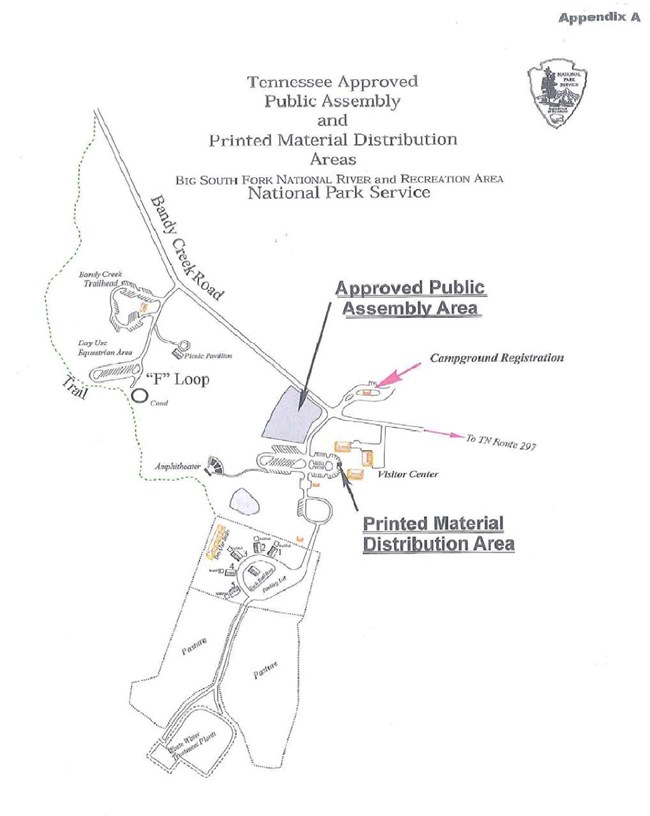
APPENDIX A: Approved Public Assembly and Printed Materials Distribution Areas in TennesseeRETURN TO TOPAPPENDIX A 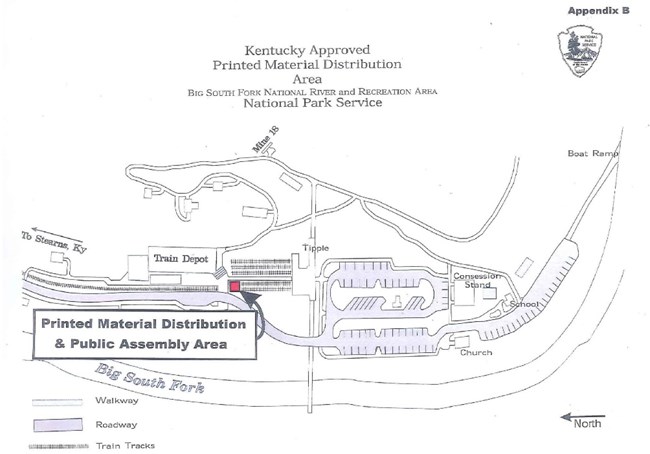
APPENDIX B: Approved Public Assembly and Printed Material Distribution Area in KentuckyRETURN TO TOPAPPENDIX B |
Last updated: September 18, 2025


